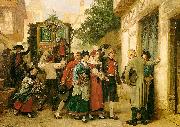Wholesale Oil Painting Reproductions No Minimum and Door to Door! |
|||||||||||
|
|
|||||||||||

|
|||||||||||
|
|
|
||||||||
All Gustave Brion Oil Paintings |
||||||||
|
|
||||||||
|
|
||||||||
|
Artist Introduction: 1824-1877 French
French painter and illustrator. His family settled in Strasbourg in 1831 and placed him in the studio of the portrait and history painter Gabriel-Christophe Gurin (1790-1846) in 1840. He then earned his living mainly by teaching drawing and copying paintings. In 1847 he successfully submitted his first work to the Salon: Farmhouse Interior at Dambach (untraced). In the summer of 1850 he moved to Paris, where he took a studio in a house shared by Realist artists. Brion exhibited regularly at the Salon: in 1852 The Towpath (untraced) was bought by the de Goncourt brothers; and in 1853 he showed the Potato Harvest during the Flooding of the Rhine in 1852 (Nantes, Mus. B.-A.), in which the influence of Gustave Courbet and Jean-Francois Millet (ii) can be seen in the Alsatian peasant figures. |
||||||||
|
|
||||||||
|
Wedding Procession Painting ID:: 215 |
1873
Musee des Beaux-Arts, Strasbourg |
|||||||
Height Width |
INS/CM Quality |
|||||||
|
X |
| |||||||
|
|
||||||||
All Elihu Vedder Oil Paintings |
||||||||
|
|
||||||||
|
|
||||||||
|
Artist Introduction: American Symbolist Painter, 1836-1923
American painter, illustrator, sculptor and writer. He studied under Tompkins Harrison Matteson in Shelbourne, NY, and went to Paris in March 1856. After eight months in the studio of Fran?ois-Edouard Picot, he settled in Florence until the end of 1860. There he learnt drawing from Raffaello Bonaiuti, became interested in the Florentine Renaissance and attended the free Accademia Galli. A more significant artistic inspiration came from the Italian artists at the Caff? Michelangiolo: Telemaco Signorini, Vincenzo Cabianca (1827-1902) and especially Nino Costa (1827-1902). This group sought new and untraditional pictorial solutions for their compositions and plein-air landscapes and were particularly interested in the experiences of Gustave Courbet and the Barbizon painters. They became known as Macchiaioli for their use of splashes (macchia) of light and shadows and for their revolutionary (maquis) attitude to prevailing styles. Among Vedder's most notable Florentine landscapes are Mugnone Torrent near Fiesole (Detroit, MI, Inst. A.) and Le Balze, Volterra (Washington, DC, N. Mus. Amer. A.) |
||||||||
|
|
||||||||
|
|
Wedding Procession Painting ID:: 71620 |
between 1872(1872) and 1875(1875)
Oil on canvas
46 x 149.4 cm (18.11 x 58.82 in)
|
||||||
Height Width |
INS/CM Quality |
|||||||
|
X |
| |||||||
|
|
||||||||
All Elihu Vedder Oil Paintings |
||||||||
|
|
||||||||
|
|
||||||||
|
Artist Introduction: American Symbolist Painter, 1836-1923
American painter, illustrator, sculptor and writer. He studied under Tompkins Harrison Matteson in Shelbourne, NY, and went to Paris in March 1856. After eight months in the studio of Fran?ois-Edouard Picot, he settled in Florence until the end of 1860. There he learnt drawing from Raffaello Bonaiuti, became interested in the Florentine Renaissance and attended the free Accademia Galli. A more significant artistic inspiration came from the Italian artists at the Caff? Michelangiolo: Telemaco Signorini, Vincenzo Cabianca (1827-1902) and especially Nino Costa (1827-1902). This group sought new and untraditional pictorial solutions for their compositions and plein-air landscapes and were particularly interested in the experiences of Gustave Courbet and the Barbizon painters. They became known as Macchiaioli for their use of splashes (macchia) of light and shadows and for their revolutionary (maquis) attitude to prevailing styles. Among Vedder's most notable Florentine landscapes are Mugnone Torrent near Fiesole (Detroit, MI, Inst. A.) and Le Balze, Volterra (Washington, DC, N. Mus. Amer. A.) |
||||||||
|
|
||||||||
|
|
Wedding Procession Painting ID:: 72819 |
Date between 1872(1872) and 1875(1875)
Medium Oil on canvas
Dimensions 46 X 149.4 cm (18.11 X 58.82 in)
cyf |
||||||
Height Width |
INS/CM Quality |
|||||||
|
X |
| |||||||
|
|
||||||||
|
Prev Next
|
||||||||
|
|
||||||||
|
Related Paintings to Elihu Vedder :. |
||||||||
|
|
||||||||
|
CONTACT US |



